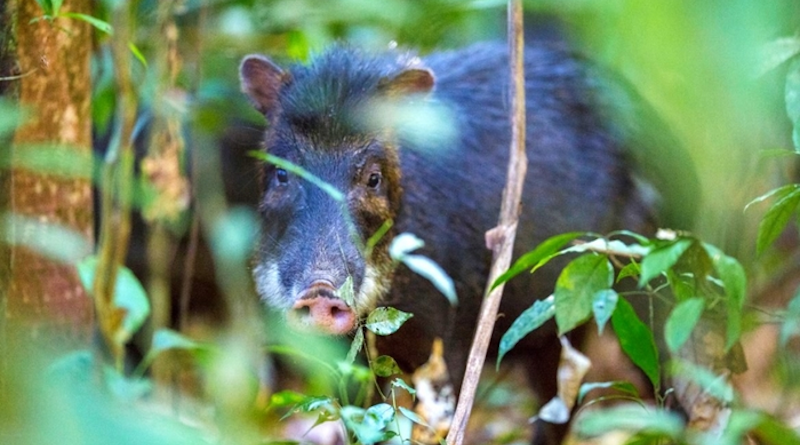Tapirs And Large Peccaries Are Key To Ecological Balance In Neotropical Forests
A study conducted by researchers affiliated with São Paulo State University (UNESP) in Brazil shows that large mammals have a major impact on plant diversity, primary productivity and biomass in the understory of Neotropical forests. Species like the Lowland tapir (Tapirus terrestris) and White-lipped peccary (Tayassu peccari) help keep an ecological balance in areas such as the Atlantic Rainforest with different levels of productivity, while also influencing the spatial structure of plant communities. An article on the study is published in Perspectives in Ecology and Conservation.
The authors also show that these two key herbivore species perform complementary roles. Tapirs help regulate plant diversity, while peccaries contribute to productivity, biomass, and understory seedling density. Meanwhile, the Jussara palm (Euterpe edulis) plays a key role in the process of spatial regulation by attracting animals with its enormous quantity of fruit.
The animals eat the fruit and disperse the seeds, trampling the soil as they move through the forest and leaving behind large amounts of droppings. All this increases seedling productivity by up to 185% in less productive areas, while reducing it by more than 190% in more productive areas. As a result, differences in productivity between habitats are evened out.
Tapirs swallow fruit practically whole, chewing only the pulp. Seeds pass through their digestive system intact and reach the soil ready to germinate. They range over large areas and often defecate far away from the plants whose fruit they eat, carrying seeds from one side of a forest area to another, and changing the composition and diversity of the plant communities that live there.
Peccaries consume seeds and seedlings, reducing understory density and trampling the soil with their sharp hooves. These processes, combined with excretion, boost primary productivity understood as the production of new biomass in response to ecosystem carbon flows, among other factors.
“This spatial structuring phenomenon is poorly understood and hasn’t been studied in depth, but it’s a fundamental part of these species’ role as ‘forest engineers’. Indeed, scientists consider them foundational species in Neotropical forests. Our study shows how mammals affect forest dynamics in different ways. Depending on the number of palm trees, they increase or reduce productivity and affect biodiversity so that it all becomes more balanced,” Nacho Villar, first author of the article, told Agência FAPESP.
Villar’s research was supported by a scholarship from FAPESP. He is a postdoctoral fellow at the Institute of Biosciences (IB-UNESP) in Rio Claro.
FAPESP also supported the study via funding for two other projects for which the principal investigator was Mauro Galetti, a professor at IB-UNESP, under the aegis of the FAPESP Research Program in Biodiversity Characterization, Conservation, Restoration and Sustainable Use (BIOTA-FAPESP).
“Floristic censuses show that palms are dominant in terms of abundance in Neotropical forests such as the Atlantic Rainforest and the Amazon. Tapirs and peccaries are found throughout the Neotropics. So our findings probably apply to many other forests in the south and center of the American continent,” Villar said.
Mutual relations among the two animal species and E. edulis are ecologically key to biodiversity and productivity in the Atlantic Rainforest, he added. Hence the importance of their conservation. “Profound changes in primary productivity caused by defaunation [decline in populations of top predators and herbivores] have a significant impact on the forest’s capacity for carbon capture,” he said.
Several studies have shown that large mammals stimulate primary productivity in areas of tallgrass prairie such as African savannas, but this also happens in tropical forests, according to his group’s research. As noted by the latest study, extinction of large mammals, illegal cutting of Jussara palms for human consumption and deforestation generally lead to major changes in the structure, biomass and diversity of Neotropical forests.
According to SOS Mata Atlântica, a nonprofit founded in 1986 to promote conservation of the Atlantic Rainforest, only 12.4% of the biome’s original vegetation is left. In São Paulo State alone, deforestation rose 406% between 2019 and 2020 compared with 2018-19 (from 43 hectares to 218 hectares). Tapirs and peccaries are classed as endangered species in the state.
“In 2019, we were told by the manager of a state park in São Paulo that many adult palm trees were felled in a single week. That changes the forest, which ceases to exist as we know it. It’s similar to climate change: people feel nothing’s happening but it is. It’s a tragedy,” Villar said.

